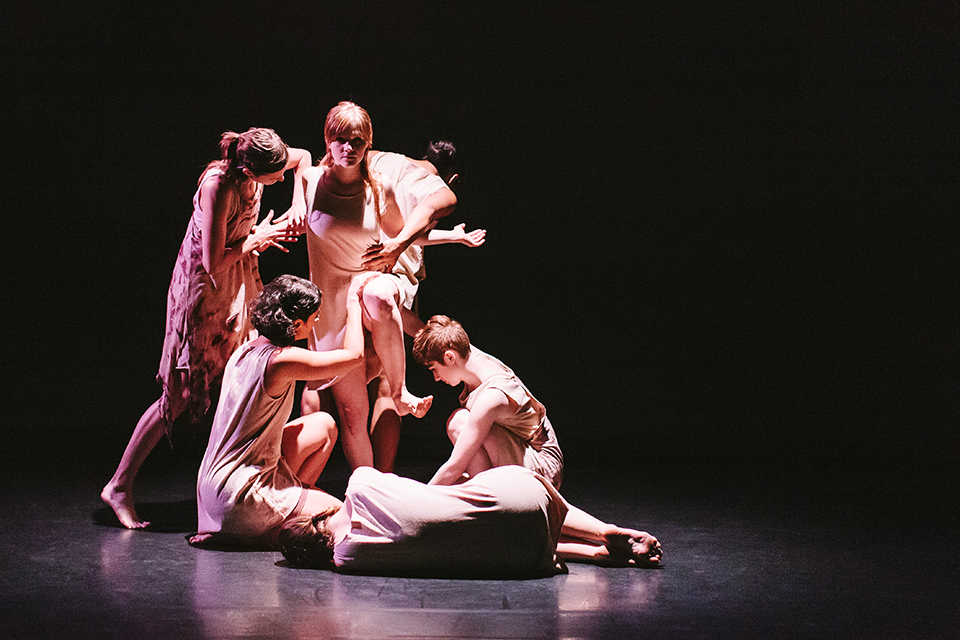Regifting Lions

Photos by Lynn Lane
October 25-27, 2012
Barnevelder
However hard the blows life can inflict, it is what comes afterward that determines the quality of one’s life, whether one survives or succumbs.
Regifting Lions, a collaboration of Lynn Lane, Catalina Molnari and Toni Leago Valle, explores the question “Why do some stagger and crumple in the aftermath of trauma, while others find the strength to move forward with their lives?”
The show opens with the sound of a ticking clock – an intimation of mortality that reminds us of our short time on Earth, a time that can be cut even shorter by illness or accident. Dancers alternate between embracing and walking a tight rope, between strength through connection and the need to maintain a balance between traumatic past and the healing present, between acknowledging pain and preserving connection with those who cannot confront the pain of others. A woman on stage is surrounded by hands that impede her progress forward – an image that can refer either to a family who wishes to live in denial or to the illness itself. The sense of struggle is palpable.
Dancers curl repeatedly in fetal positions – an image both of despair and rebirth. A phone rings. Someone wants to talk. Or perhaps it is the harbinger of bad news. Dancers carry each other, like a baby or a burden.
Later in the piece there is a rhythmic whooshing, like a breathing machine. Chords sound like a clock striking. In other literature, cancer survivors have been quoted as saying that the cancer diagnosis was their “wake up call,” a gift that prodded them to truly live their lives.Regifting Lions offers many images of the joy life has to offer to those who look Death in the eye, only to have Death blink. Jumps are buoyant; hands are examined with the wonder of something new and marvelous.
Yet, the power of survivorship lies in the contrast between trauma and the ability to nonetheless embrace and celebrate the human experience.Regifting Lions seems to skirt some of the agony of trauma. While flailing arms do convey attempts to get away from pain, they cannot describe the full panoply of fear, grief, and disbelief, nor the bargaining, that are inextricable from any traumatic situation. It’s one premise of Regifting Lions, that it is the clear-eyed acknowledgment of trauma that allows healing to take place. It’s this “allowing” of trauma to be its raw and ugly self, which can lead not only to recovery, but also to a sort of transcendence. Grief can have its own kind of beauty.
This is not the same thing as making movement pretty, as indeed passages of Regifting are. There is also the danger, in using movements that are too literal, of substituting telling for showing. There are, at crucial points in Regifting, a disconnect between gestures and their intended meaning. Movements are danced as if they have more significance than they actually carry.
For these collaborators, the role of familial patterns, and the need to “regift” the dysfunctional coping skills that have been handed down through generations, is a significant piece in the survivorship struggle. Inner strength and the strength found through interpersonal relationships — the “Lions” of the title – are also crucial factors in recovering from trauma.
For Lane, himself a cancer survivor, Regifting Lions was an extension of his work as founder of Voices of Survivors, a project he started to “put a human face and voice to the word ‘cancer survivor’.” Valle and Molnari brought their own life struggles to the piece. For all three collaborators, the emphasis of their work is clearly on, not merely surviving a trauma, but using it to develop deeper self-awareness and closer emotional ties with others, to live life more fully.
Performers were Houston veterans Jesus Acosta, Roberta Cortes, Lindsey Thompson, and Brit Wallis, and newcomers Alexandra DiNunzio and Emily Robison. George Heathco created an original score while Kris Phelps’ lighting design brought depth to the piece.



Recent Comments